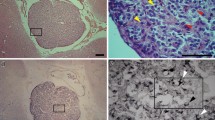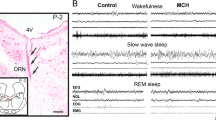Summary
This study tested the photo-dependency of the rhythmic synthesis of 5-methoxytryptamine (5-MT) in the pineal gland of golden hamsters. After pargyline administration, pineal 5-methoxytryptamine and melatonin were measured by HPLC in male golden hamsters kept under short and long photoperiod. In both photoperiodic regimes, a clear 5-MT rhythm was observed which fitted a sinusoidal function with high values occuring during the day-time and low values occuring during the night-time. The duration of the low nighttime levels was clearly proportional to the length of the dark phase. A marked rhythm of melatonin synthesis was also seen with low daytime levels and high night-time values. An inverse relationship between 5-MT and melatonin levels was observed. Thus, after pargyline administration, the rhythms of 5-MT and melatonin in the pineal gland of golden hamsters are photoperiod-dependent and show a reciprocal relationship.
Similar content being viewed by others
References
Brainard GC, Richardson BA, Petterborg LJ, Reiter RJ (1982) Pineal melatonin in Syrian hamsters: circadian and seasonal rhythms in animals maintained under laboratory and natural conditions. Neuroendocrinology 35: 342–348
Cahill GM, Besharse JC (1989) Retinal melatonin is metabolized in the eyes ofXenopus laevis. Proc Natl Acad Sci USA 86: 1098–1102
Czyba JC, Girod G, Durand N (1964) Sur l'antagonisme epiphyso-hypophysaire et les variations saisonnieres de la spermatogenese chez le hamster dore (Mesocricetus auratus). C R Soc Biol 158: 742–745
Deguchi T, Axelrod J (1972) A sensitive assay for serotonin N-acetyltransferase activity in rat pineal. Anal Biochem 50: 174–179
Galzin AM, Eon MT, Esnaud H, Lee CR, Pevet P, Langer SZ (1988) Day-night rhythm of 5-methoxytryptamine biosynthesis in the pineal gland of golden hamster (Mesocricetus auratus). J Endocr 118: 389–397
Goldman MD (1983) The physiology of melatonin in mammals. Pineal Res Rev 1: 145–182
Hadfield MG, Milio C, Narasimhachari N (1987) Simultaneous HPLC analysis of catecholamines and indoleamines in mouse brain tissue following acetate extraction and treatment with ascorbate oxidase. J Liquid Chromatogr 10: 2439–2446
Heward CB, Hadley ME (1979) Structure-activity relationship of melatonin and related indoleamines. Life Sci 17: 1167–1178
Hoffman R, Reiter RJ (1965) Pineal gland. Influence on gonads of male hamster. Science 148: 1609–1611
Jones RSG (1982) Tryptamine a neuromodulator or neurotransmitter in mammalian brain? Prog Neurobiol 19: 117–139
King T, Richardson A, Reiter RJ (1982) Regulation of rat pineal melatonin synthesis: effect of monoamine oxidase inhibition. Mol Cell Endocrinol 25: 327–338
King T, Steger RW, Richardson BA, Reiter RJ (1982) Interaction between pargyline monoamine oxidase inhibitor and beta-adrenergic receptors in the rat pineal gland. In: Reiter RJ (ed) Progress in clinical and biological research. The pineal gland andits hormones. Alan R Liss, New York, pp 95–100
Klein DC, Weller JC (1970) Rapid light-induced decrease in pineal serotonin N-acetyl-transferase activity. Science 168: 979–980
Oxenkrug GF, McIntyre IM, Balon R, Jain AK, Appel D, McCauley RB (1986) Single dose of tranylcypromine increases human plasma melatonin. Biol Psychiatry 21: 1085–1089
Panke ES, Rollag MD, Reiter RJ (1979) Pineal melatonin concentrations in the Syrian hamster. Endocrinology 104: 194–197
Pévet P, Haldar-Misra C, Ocal T (1981) Effect of 5-methoxytryptophan and 5-methoxy-tryptamine on the reproductive system of the male golden hamster. J Neural Transm 51: 303–311
Pévet P (1983 a) The 5-methoxyindoles different from melatonin; their effects on the sexual axis. In: Axelrod J, Fraschini F, Velo GP (eds) The pineal gland and its endocrine role. Plenum, New York, pp 331–341
Pévet P (1983 b) Is 5-methoxytryptamine a pineal hormone? Psychoneuroendocrinology 8: 61–73
Pévet P (1985) 5-methoxyindoles, pineal peptides and reproduction. In: Brown GM, Wainwright SD (eds) The pineal gland: endocrine aspects. Pergamon, Oxford, pp 81–102
Pulchalski WG, Lynch R (1988) Daily melatonin injections affect the expression of circadian rhythmicity in Djungarian hamsters kept under long day photoperiod. Neuroendocrinology 48: 280–286
Raynaud F, Miguel JL, Vivien-Roels B, Masson-Pévet M, Pévet P (1989) The effect of 5- methoxytryptamine on golden hamster gonads is not a consequence of its acetylation into melatonin. J Endocr 121: 507–512
Reiter RJ (1980) Photoperiod, pineal and reproductive rhythms. In: Brambilla F, Rocagni D, de Weid D (eds) Progress in psychoneuroendocrinology. Elsevier, Amsterdam, pp 116–126
Roberts AC, Martensz ND, Hastings MH, Herbert J (1985) Changes in photoperiod alter the daily rhythm of pineal melatonin content and hypothalamic endorphin content and the luteinizing hormone response to naloxone in the male Syrian hamster. Endocrinology 117: 141–148
Rollag MD (1982) Ability of tryptophan derivatives to mimic melatonin's action upon Syrian hamster reproductive system. Life Sci 31: 2699–2707
Snyder S, Axelrod J, Zweig M (1967) Circadian rhythm in the serotonin content of the rat pineal gland: regulating factors. J Pharmacol Exp Ther 158: 206–213
Skene DJ, Pevet P, Vivien-Roels B, Masson-Pevet M, Arendt J (1987) Effect of different photoperiods on concentrations of 5-methoxytryptophol and melatonin in the pineal gland of the Syrian hamster. J Endocr 114: 301–309
Vanecek J, Jansky L, Illnerova H, Hoffman K (1984) Pineal melatonin in hibernating and aroused golden hamsters (Mesocricetus auratus). Comp Biochem Physiol 77 A: 759–762
Warsh JJ, Coscina DV, Dodse DD, Chan PW (1979) Dependance of brain tryptamine formation on tryptophan availability. J Neurochem 32: 1191–1196
Weil-Malherbe H (1976) Amine formation from L-trypophan in brain slices. J Neurochem 27: 29–834
Author information
Authors and Affiliations
Rights and permissions
About this article
Cite this article
Raynaud, F., Pévet, P. Effect of different photoperiods on the diurnal rhythm of 5-methoxytryptamine in the pineal gland of golden hamsters (Mesocricetus auratus). J. Neural Transmission 83, 235–242 (1991). https://doi.org/10.1007/BF01253393
Received:
Accepted:
Issue Date:
DOI: https://doi.org/10.1007/BF01253393




